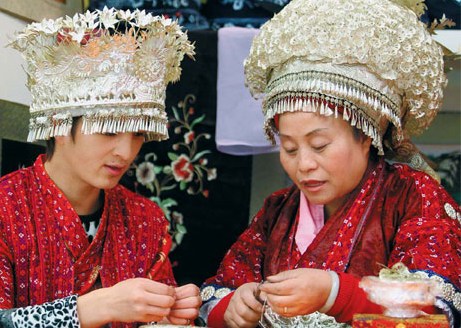
Yang Yufen (right) makes silver crown ornaments at the exhibition. The silver crown she wears weighs 3 kg. Photos by Feng Yongbin / China Daily
Visitors to a recent exhibition in Beijing could see how ethnic Miao culture is reflected in its silver ornaments and how other group's handicrafts convey their customs.
From Dec 22 to Dec 26, Amazing Guizhou displayed ethnic Miao horsetail embroidery, silver crowns, festival attire and Guizhou batik in Beijing's 798 art zone.
The province is among the country's most ethnically diverse. It's home to 12.5 million people of 53 ethnic groups, all of which have unique culture and folk arts.
The Miao silver crown is among the most eye-catching ornaments.
Silver represents good luck in Miao culture, and children wear ornaments made from the metal, such as necklaces, from birth. Women wear the headgear during festivals.
The tradition of creating silver accessories was born when the Miao needed to bring their silver with them as they migrated across the country as war refugees in ancient times. They discovered wearing the precious metal to be an efficient way to transport it.
The crowns weigh between 1 and 3 kg.
Most ethnic groups in Guizhou don't have written languages, so they have used handicrafts to record history.
"Hundreds of flowers are engraved on every crown, which is also set with bells that jingle when you walk," 21-year-old Miao woman Wu Yani explains. "A silver belt in the middle of the crown is carved with images that portray the history of the Miao's migration."
The crown displayed in Beijing was created by 50-year-old Yang Yufen.
"I worked for four days without sleep to finish this crown for the exhibition," she says.
Earlier this month, Yang took her crowns to Italy for the Chinese Cultural Year of Italy. She and other craftspeople demonstrated the process of making handicrafts to exhibition visitors.
The Beijing exhibition was attended by Liu Bo, China Central Academy of Fine Arts professor and the designer of the 2008 Beijing Paralympics Games emblem.
"I came twice to learn about folk art," Liu says. "These handicrafts are wonderful. Each shows local people's passion for life. You can read their lives in their ornaments. I truly wonder how they create such art with just their hands."
Liu hopes to someday take his students to Guizhou, he says.
"Most of my students are in their 20s and live in urban areas," Liu says. "They don't have many chances to learn about art from China's grassroots. I believe learning from folk artists will inspire them as much as the exhibition has inspired me."

Copyright ©1999-2011 Chinanews.com. All rights reserved.
Reproduction in whole or in part without permission is prohibited.